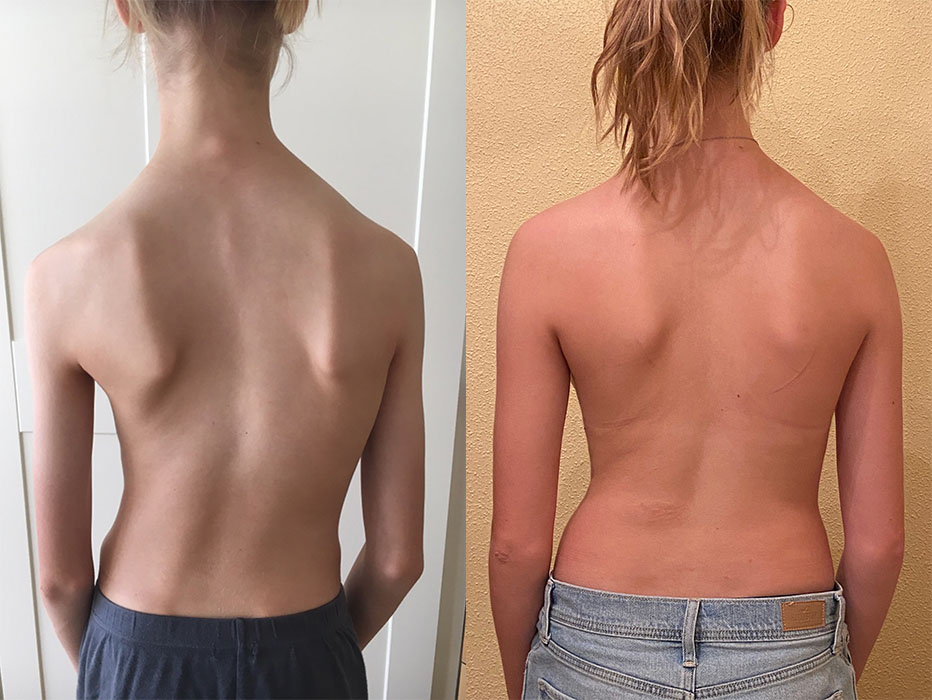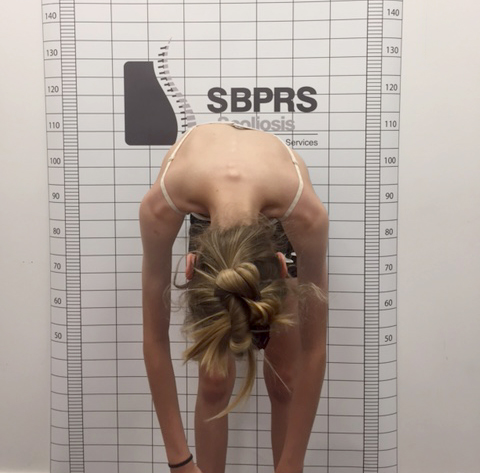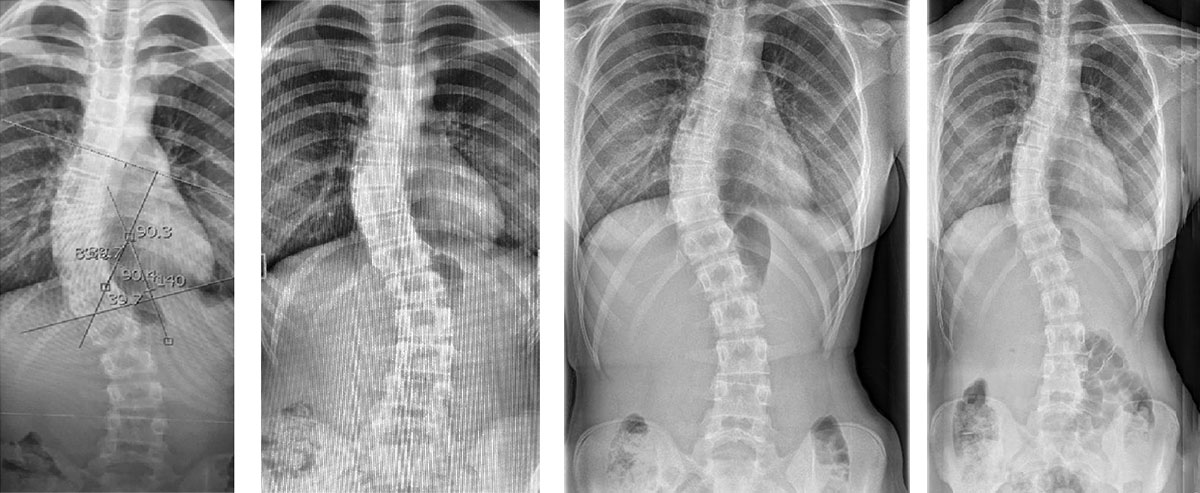
Before and after images show Sofia's back at the start of treatment (left) and towards the end of her treatment (right).
16 August 2023
Sofia, who is now 19 years of age, has now been out of her LOC scoliosis brace for over a year and there has been no regression in her curve. Because she is now skeletally mature it means she should not require surgery in later life. We spoke to her and mum Elena about their experience of bracing treatment.
Elena found out something was wrong with her daughter’s back by chance. It was a hot Easter in 2018 and the family were on holiday. Sofia was changing into her bikini and Elena was startled by a noticeable S-shaped curve in her back and asymmetric shoulders.
Elena went into research mode and, following a conversation with a physiotherapist friend, started reading about scoliosis. As there was no family history of scoliosis, they concluded that Sofia must have adolescent idiopathic scoliosis. They were recommended a Spanish clinic that used the Cheneau-Gensingen brace to correct scoliosis curves as Elena herself is Spanish.

Sofia doing the Adams forward bend test to check for scoliosis. In this test, the person bends forward with feet and knees aligned and arms hanging freely. Imbalances in the rib cage or back deformities can indicate scoliosis.
In the meantime, the family GP referred Sofia to a consultant and X-rays were taken that showed Sofia had a 40-degree Cobb angle, so they recommended surgery to correct it. Elena was keen to avoid surgery if possible and set about researching whether there were clinics in the UK that offered the Cheneau – Gensingen brace. Elena found LOC and Sofia was first seen in June 2018.
Sofia recalls: “The wearing regime was initially daunting – knowing I’d have to spend 21 to 22 hours a day in the brace – but you do get used to it and you know that for the bracing treatment to work and to avoid surgery you really just need to get on with it. I told my close friends what was going on, funnily enough my secondary school uniform was very baggy, so the brace didn’t really show. I am a keen football player (left back) so I obviously needed to take the brace off while playing. Sleeping in a brace was also tricky initially but, again, you get used to it as it sort of becomes part of you.”
Elena adds: “We saw a lot of Anna Courtney (LOC’s lead scoliosis clinician) as Sofia’s brace needed continuous adjustment as she was going through various growth spurts. Anna was very good with Sofia, asking how she was feeling and doing everything possible to make the brace as comfortable as possible to wear while being totally encouraging about the eventual outcome.”

X-rays show Sofia's S-curve improving over time.
Scoliosis is a condition where there is an abnormal curvature of the spine. It is a three-dimensional condition with deviation of the vertebrae in the sagittal, coronal and transverse planes.
Treatment recommendations are based on the Cobb angle of the patient and the risk of progression. For curves under 20 degrees, we monitor the patient’s curve while the patient undertakes a tailored exercise programme based on Schroth principles; this is delivered by our partner in providing scoliosis treatment, Scoliosis SOS.
For curves above 20 degrees, we prescribe our LOC Scoliosis Brace which works three-dimensionally to guide the patient’s spine into a more correct position, substantially reducing their Cobb angle. For optimum correction, we recommend that bracing is combined with specialist physiotherapy.
This joint approach means our patients are getting the best and most appropriate advice from two scoliosis specialists, one with an orthotic perspective and one with a physiotherapy perspective.
LOC makes the vast majority of orthotics we fit, and our scoliosis brace is no exception. It is difficult to over-emphasize how important it is to have our own manufacturing unit on site. Lead times are shorter because we are not reliant on outside suppliers, and we can fine-tune our braces at the fitting stage to ensure optimum efficacy and comfort.
The LOC Scoliosis Brace is a 3D, hypercorrective, Cheneau-Gensingen derivative brace, known as one of the most corrective and modern scoliosis braces available in the UK. It is designed to:
The brace is entirely unique and tailored to the patient’s spinal curve pattern, ensuring optimal skeletal correction while prioritising comfort.
Unlike traditional braces, it opens from the front for easier self-application and maintains a low profile under clothing.
The LOC Scoliosis Brace is worn 22 hours a day (including nighttime) and works in conjunction with Schroth-based therapy for maximum results.
Typically, there is an initial consultation followed by a fitting appointment and then pre- and post-reviews after in-brace x-rays; thereafter reviews every three months until the end of treatment. For the majority of our patients who are adolescents, we believe it is essential that there are regular assessments and reviews to ensure that the brace is fitting well; we will make tiny adjustments to the brace to ensure optimum comfort and optimum correction. We have found that comfort is a major contributor to an individual’s compliance with the prescribed wearing regime. In addition, the close contact between patient and clinician ensures patient motivation resulting in better outcomes at the treatment end.
We are pleased to offer a free-of-charge, virtual assessment should you wish to be screened for scoliosis. If we feel a referral to an Orthopaedic Consultant is warranted, we recommend a consultation at The Wimbledon Clinic, Parkside with Mr Darren Lui, Mr Jason Bernard or Mr Tim Bishop. The consultant would arrange the imaging as required. Obviously, you can also seek advice from your family GP.
Over the course of her bracing treatment, which included a specialised exercise programme, her wearing regime reduced from 22 to 18 to 16 hours a day and Sofia spent less time in the brace. Eventually this went down to 8-hours of nighttime-wear only. Sofia stopped wearing the brace last summer. Now, she says, “I am actually quite fond of it! I’ve kept it in a cupboard. I am just so thankful that I don’t need an operation”.
Elena concludes: “We are really pleased with her cosmetic appearance. It’s so different to what she looked like before treatment.”
Since January 2022, LOC has been producing its own Cheneau- Gensingen derivative scoliosis brace. 18 months of clinical data shows the in-brace curve correction we achieve with the LOC Scoliosis brace is just over 86%. This compares with Boston braces which achieve 50% and other asymmetric braces that are available in the UK that can only achieve between 50-65%.
We offer a free virtual scoliosis appointment for those seeking scoliosis advice and treatment. This initial free virtual consultation is carried out through Skype, Facetime or Zoom.
During the appointment, you will have the opportunity to talk directly to one of our specialist clinicians about your child’s scoliosis. During this 15-minute appointment, your clinician will be able to answer any detailed questions or concerns you might have prior to booking a face-face assessment with us.
If your child has recently been diagnosed with scoliosis or you think they are showing signs of the condition, please get in touch to book an appointment today.